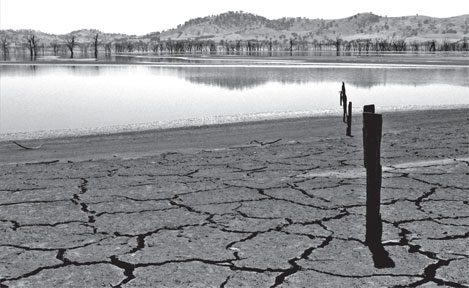Desertification - a growing problem
by Pramod de SILVA
Can you imagine a desert exactly the size of Sri Lanka (65,610 Sq
Km)? If we place Sri Lanka in the Mojave Desert in the USA, they will
match almost perfectly. But if it is difficult to imagine a desert the
size of Sri Lanka, Sahara, the world's biggest desert, would be
mind-boggling at 9,400,000 square kilometres. We can easily place 143
islands of Sri Lanka's size there. Indeed, that is a very big land area!
  Amazing
as that may seem, deserts are getting bigger all the time in a process
called desertification - the persistent degradation of dryland
ecosystems by human activities and climatic variations. The term
desertification was first coined by French scientist and explorer Louis
Lavauden in 1927. Amazing
as that may seem, deserts are getting bigger all the time in a process
called desertification - the persistent degradation of dryland
ecosystems by human activities and climatic variations. The term
desertification was first coined by French scientist and explorer Louis
Lavauden in 1927.
Desertification was defined at the Rio Earth Summit in 1992 as
degradation of drylands, the point at which that land no longer can be
returned to a productive state.
Because of its toll on human well-being and on the environment, it
ranks among the greatest development challenges of our times. Deserts
are not totally 'dead' in the strictest sense of the word, for life
finds a way even in the harshest of environments. But desertification
means the loss of valuable arable lands and forest land. It is
happening, albeit slowly, everywhere.
About one-third of the world`s land surface is arid or semi-arid. It
is predicted that global warming will increase the area of desert
climates by 17 percent in the next few decades. Worldwide
desertification is claiming 20,000 square miles of land annually. Even
the Sahara desert is advancing southwards by about 5-10 kilometres per
year.
Desertification has now become a worldwide issue and many countries
are keen to stop desertification on their soils, literally. This is why
the UN has proclaimed a World Day to Combat Desertification and Drought.
It is observed all over the world on June 17 every year.
The aim of the United Nations in designating a day of observance is
to educate the public and policy-makers on the increasing dangers of
desertification, land degradation and drought.
Environmental events
This year's environmental events are centered on one theme: Forests.
This is the International Year of Forests. The World Environment Day on
June 5 was celebrated on the theme Forests: Nature at Your Service.
On the same lines, the World Day to Combat Desertification for 2011
will focus specifically on the forests in the dry land areas of the
world, guided by the motto: 'Forests keep drylands working'.
 As
the UN points out, desertification, land degradation and drought (DLDD)
threaten human security by depriving people of the means to decent
livelihoods. They undercut food production, access to water and the
means to economic activity, and even destroy their homes. As
the UN points out, desertification, land degradation and drought (DLDD)
threaten human security by depriving people of the means to decent
livelihoods. They undercut food production, access to water and the
means to economic activity, and even destroy their homes.
Turning to the theme for the year, land degradation in the drylands
(desertification in other words), begins with the clearing of
vegetation.
"Forests are the first step towards healing the drylands and
protecting them from desertification and drought," says Luc Gnacadja,
Executive Secretary of the UN Convention to Combat Desertification.
Dry forests may become the single most important determinant of the
future sustainability of the drylands as the impact of climate change
escalate. Yet, only 18 percent of the drylands is forested.
In his call to the international community in February when unveiling
the 2011 theme, Gnacadja said, "If each of us makes the commitment and
ensures that just one tree is planted in a degraded part of the drylands
and that the tree survives through the year, we could have well over two
billion trees in the drylands by the end of the year. That is a tree for
every inhabitant. Let us go forth and forest the drylands to keep them
working for present and future generations."
This is indeed a noble call, for trees literally mean life for the
two billion inhabitants that call drylands 'home'. They provide food and
medicine for the people and their livestock. They are their places of
worship and shelter and their decision-making centres.
Food security
These forests are the 'invisible' backbone of humanity's food
security. One in every three plants under cultivation originated here
and now provide globally-consumed crops such as wheat, barley, sorghum,
corn, cabbage, potatoes and olives.
Thus, saving the drylands has become a priority especially in places
where desertification is rife such as Africa and even South America. The
recent African Drylands Week was a step in this direction.
Drylands are in the spotlight due to another unlikely reason. The
pressure on arid zone forests that protect them may increase, especially
in the tropical and sub-tropical regions, from two opposing forcesw.
There is a global campaign to conserve the moist tropical forests for
carbon sequestration, on the one hand, and the need to open up new land
for agriculture to meet a growing global demand for biofuels, food and
poverty eradication on the other.
Increasingly, this pressure is being eased by reverting to the
drylands.
Thus drylands too are being cut down and reduced, which could lead to
desertification. No country is immune from desertification in this light
as the unsustainable use of local resource continues everywhere.
But desertification can be prevented and even reversed in rare
instances. Establishing seed banks, reintroducing selected flora and
fauna, countering erosion, enriching the soil with nutrients and
planting trees in the drylands are some of the suggestions made by
agricultural and climate experts.
The sustainable use of all dryland resources is another. More
efficient use of existing water resources (better irrigation practices)
and control of salinisation are other effective tools.
Climatic phenomenon
Drought is a climatic phenomenon closely linked to desertification.
It is a climatic condition that prevails when there is little or no rain
in a given geographical area. Any country can face a drought - remember
the long drought in Sri Lanka in 1996? A drought can last for a week, or
for several years at a stretch. The UN estimates that an area of fertile
soil the size of Ukraine (603,700 Sq Km) is lost to agriculture every
year due to drought.
 What
can we do to prevent drought? In the long term, reforestation is an
ideal answer. Among the other steps are better agricultural practices
such as crop rotation (slash and burn cultivations increase the risk of
drought), streamlined land use, outdoor water use restrictions (such as
on washing cars), rainwater harvesting, recycling water and building
better irrigation systems in drought-prone areas. What
can we do to prevent drought? In the long term, reforestation is an
ideal answer. Among the other steps are better agricultural practices
such as crop rotation (slash and burn cultivations increase the risk of
drought), streamlined land use, outdoor water use restrictions (such as
on washing cars), rainwater harvesting, recycling water and building
better irrigation systems in drought-prone areas.
Limiting grazing by livestock is another option. Like
desertification, droughts affect billions of people worldwide.
These are two inter-connected issues that the international community
must address without delay in the run-up to the 2012 Earth Summit in
Rio. Desertification and drought affect not only the climate patterns,
but also the livelihoods of billions around the world. It is not a
completely lost cause as outlined above, there are plenty of steps that
can be taken to stop desertification along the drylands.
The World Day to Combat Desertification is an ideal opportunity to
embark on such ventures on a worldwide scale. On an individual level, a
simple act such as planting a tree can contribute to controlling
desertification even in a small way.
This fits in ideally with the overall theme of forests for this
year's environmental activities too.
|

